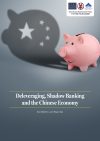Private equity dampens business cycle fluctuations, improves capital allocation, and boosts growth, argues Economics professor Christian Keuschnigg at the University of St. Gallen
Innovation is a process of trial and error. It is the essence of the Schumpeterian entrepreneur to take risks and accept failure when new ideas do not convince customers. Successful firms prosper and are the source of new fortunes; others fail to deliver an acceptable return or, in the worst case, must be liquidated to limit the losses. Bankruptcy cleans up the business sector to make place for the growth of profitable companies and the entry of new innovators.
Shock absorbers
Financing firms is easy when the economy is buoyant and prospects look good. Even then, investors must make sure not to neglect the quality of their investments. In a downturn or in a crisis, firms are hesitant to invest, and those who want to invest may not obtain credit when it is needed most. Shrinking equity capital in a recession and an overhang of debt create the conditions for a credit crunch that makes a recession more severe. The problem could be much alleviated if there were a voluminous market for private equity.
The problem originates with a shortage of equity capital. Banks cannot lend to overindebted firms with too little equity. Further credit financing is no longer safe and might swell non-performing loans when firms lack equity to absorb business risk. Equity capital is ‘risk capital’. More equity is a precondition for more credit. Firms can raise new debt only after replenishing equity capital. The same applies to banks. They can expand lending by raising more deposits but must first fill up equity buffers to preserve a healthy capitalization. If equity is not available or is slow to come, there is no alternative but deleveraging.
Deleveraging of banks and credit rationing of firms are the results of a widespread equity shortage which deepens the recession and delays the recovery.
The preferred source of equity is retained earnings. However, the accumulation of internal equity comes only in small steps and takes a long time. First, profits might be slow to come. If there is no profit, there is nothing to retain.
Second, entrepreneurs and investors need dividends. Severely cutting dividends meets resistance and sends bad signals. The resistance to dividend cuts limits retained earnings. In contrast, firms and banks could raise equity in big chunks and very fast if they had access to liquid stock markets or a voluminous private equity sector.
The debt capacity of firms and the lending capacity of banks could be immediately restored, the recession could be less severe, and recovery could set in much faster. In this way, the availability of external equity is a shock absorber.
Growth catalysts
Private equity also adds to a country’s growth potential. Accumulating internal equity by retained earnings is mostly associated with ‘business as usual’, causing no extra effort to scrutinize corporate governance and the profitability of investments.
However, a lack of managerial oversight and control is dangerous since market conditions change and firms need to adjust continuously to remain competitive. By way of contrast, when a company or a bank issues external equity, it gets intensively scrutinized by new investors who must commit to supply fresh funds.
Paying out dividends and raising external equity more often instead of relying on retained earnings increases the reallocation of equity capital. Equity must pass the market test more frequently and gets a higher chance to be steered towards its most profitable use. The performance of banks and firms and the productivity of capital can only improve. Private equity financing is associated with better governance, higher productivity, and better economic performance.
High dividend taxes in combination with low taxes on capital gains lock in the capital in their current uses and cause friction in the reallocation process, thereby slowing down productivity growth.
The productive effect of external equity is most transparent in venture capital financing of young innovative firms. Venture capital is more than just money. On top of providing equity financing, venture capitalists are intensively engaged in oversight and control of their portfolio companies, give strategic managerial advice, and help firms exploit their growth opportunities. Empirical research has established that venture capital-backed firms adopt more aggressive innovation strategies, perform substantially better and grow larger than comparable other firms. A vibrant market for private equity and venture capital boosts an economy’s growth potential.
Policy priorities for governments
Europe needs more private equity financing and larger stock markets and could reap at least three benefits. First, private equity can serve as a ‘spare tire’ when internal equity is slow to come. Providing external equity financing in big chunks immediately restores the debt capacity of firms and banks. It thereby stabilizes the business cycle, reduces the likelihood of financial crises, and speeds up recovery. Second, it’s good for the stability of banks since credit can only be safe if firms are well endowed with risk-absorbing equity. Third, it boosts growth since it improves corporate governance and supports the reallocation of equity to where it’s most productively used.
Policy reform can improve the conditions for the growth of active private equity markets. Important are good corporate governance standards and measures to strengthen investor protection. Bankruptcy law reform can support a more efficient resolution of failed firms, encourage chances for a fresh start, and facilitate reinvestment of scarce capital in more productive uses.
Private equity could also benefit from a more neutral tax system. Corporate tax reform could end the tax discrimination of equity capital by allowing deductions for the cost of equity in parallel to interest deductions for debt financing. More equal taxation of dividends and capital gains would end the lock-in of equity capital in existing firms and thereby support the smooth reallocation and more productive use of equity capital in the economy.
Finally, more systematic loss carry-forward in business taxation reduces taxes when profit is low or negative and firms are hardly able to pay, and raises tax, when profits are high in a boom and ability to pay tax is high. Taxes could thereby smooth cash flow over time and support equity capital in absorbing macroeconomic risk.
References
- Keuschnigg, C., M. Kogler, and J. Matt (2022), Banks, Credit Reallocation, and Creative Destruction, CEPR DP 17701.
- Keuschnigg, C., M. Kogler, and J. Matt. (2020), The Schumpeterian Role of Banks: Credit Reallocation and Capital Requirements, European Economic Review 122, 103349, 1-18.
- Keuschnigg, C. (2004), Venture Capital Backed Growth, Journal of Economic Growth 9, 239-261
More About Stakeholder
-
Venture capital backed innovation
Prof. Dr. Christian Keuschnigg discusses his observations regarding venture capital during his work at the Institute of Economics (FGN-HSG)





























